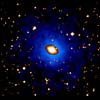| . |  |
. |
Cosmologists from Princeton University announced a new method to understand why the expansion of the universe is speeding up. The proposed technique will be able to determine if the cosmic acceleration is due to a yet unknown form of Dark Energy in the universe or if it is a signature of a breakdown of Einstein's theory of General Relativity at very large scales of the universe. The result is being presented today by the principal investigator, Dr. Mustapha Ishak-Boushaki, a research associate at Princeton University in New Jersey, to the Canadian Astronomical Society meeting in Montreal, QC. "The accelerating expansion of the universe constitutes one of the most intriguing and challenging problems in astrophysics. Moreover, it is related to problems in many other fields of physics. Our research work is focused on constraining different possible causes of this acceleration," says Dr. Ishak-Boushaki. During the last 8 years, several independent astronomical observations have demonstrated that the expansion of the universe has entered a phase of acceleration. The discovery of this acceleration came as a surprise to astrophysicists who were expecting to measure a slowing down of the expansion caused by the gravitational attraction of ordinary matter in the universe. In order to explain the cosmic acceleration, theoretical cosmologists introduced the notion of a new energy component that would constitute two thirds of the entire energy density of the universe and that is gravitationally repulsive rather than attractive. This component has been termed Dark Energy. Is Dark Energy real? "We don't know," comments Professor David Spergel from Princeton. "It could be a whole new form of energy or the observational signature of the failure of Einstein's theory of General Relativity. Either way, its existence will have profound impact on our understanding of space and time. Our goal is to be able to distinguish the two cases." The simplest case of Dark Energy is the cosmological constant that Einstein introduced 80 years ago in order to reconcile his theory of General Relativity with his prejudice that the universe is static. He had to withdraw the cosmological constant a few years later when the expansion of the universe was discovered. The discovery of the cosmic acceleration has revived the debate about the cosmological constant in a new context. Another fundamentally different possibility is that the cosmic acceleration is a signature of a new theory of gravity that enters at very large scales of the universe rather than the product of Dark Energy. Some of the recently proposed modified gravity models are inspired by Superstring theory and extra dimensional physics. Could we distinguish between these two possibilities? The proposed procedure shows that the answer is yes. The general idea is as follows. If the acceleration is due to Dark Energy then the expansion history of the universe should be consistent with the rate at which clusters of galaxies grow. Deviations from this consistency would be a signature of the breakdown of General Relativity at very large scales of the universe. The procedure proposed implements this idea by comparing the constraints obtained on Dark Energy from different cosmological probes and allows one to clearly identify any inconsistencies. As an example, a universe described by a 5-dimensional modified gravity theory was considered in this study and it was shown that the procedure can identify the signature of this theory. Importantly, it was shown that future astronomical experiments can distinguish between modified gravity theories and Dark Energy models. The research work on the results presented was led by Dr. Mustapha Ishak-Boushaki in collaboration with Professor David Spergel, both from the Department of Astrophysical Sciences at Princeton University, and Amol Upadhye, a graduate student at the Physics Department at Princeton University. Related Links Princeton University SpaceDaily Search SpaceDaily Subscribe To SpaceDaily Express  Birmingham, UK (SPX) Apr 06, 2005
Birmingham, UK (SPX) Apr 06, 2005Researchers at the University of Birmingham have used the new generation of X-ray space observatories to study "fossil galaxies" - ancient galaxy groups in which all of the large galaxies have gradually merged to form one central giant galaxy.
|
| ||||||||||
| The content herein, unless otherwise known to be public domain, are Copyright 1995-2016 - Space Media Network. All websites are published in Australia and are solely subject to Australian law and governed by Fair Use principals for news reporting and research purposes. AFP, UPI and IANS news wire stories are copyright Agence France-Presse, United Press International and Indo-Asia News Service. ESA news reports are copyright European Space Agency. All NASA sourced material is public domain. Additional copyrights may apply in whole or part to other bona fide parties. Advertising does not imply endorsement, agreement or approval of any opinions, statements or information provided by Space Media Network on any Web page published or hosted by Space Media Network. Privacy Statement All images and articles appearing on Space Media Network have been edited or digitally altered in some way. Any requests to remove copyright material will be acted upon in a timely and appropriate manner. Any attempt to extort money from Space Media Network will be ignored and reported to Australian Law Enforcement Agencies as a potential case of financial fraud involving the use of a telephonic carriage device or postal service. |